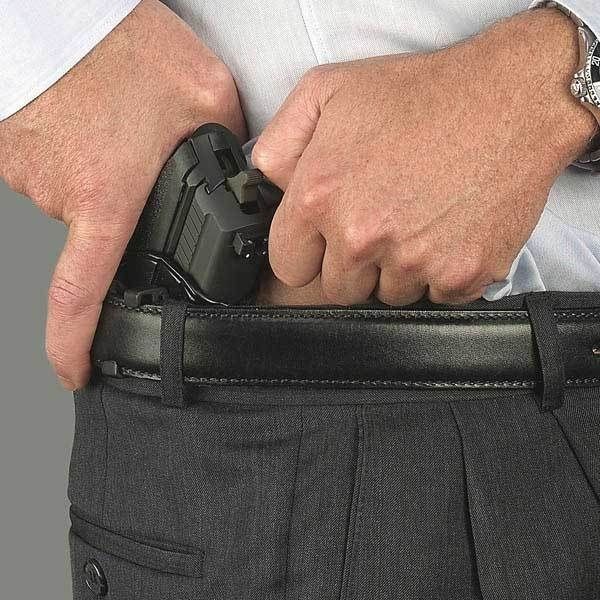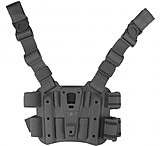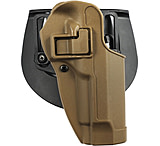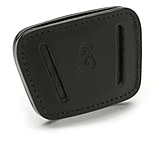Table of Contents
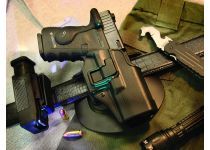 Blackhawk EDC SERPA Holster Set-Up
Blackhawk EDC SERPA Holster Set-UpAs a firearms instructor, gun store manager, private investigator, competitive shooter, and all-around gun nut, I have experience using many types of holsters for multiple purposes over the last few decades. Many of these gun holsters are quite specialized, and therefore, they currently reside in boxes and drawers in my cluttered gun room. A very few favorites are nearly as well-worn as my years-old leather wallet, and with them, I feel the same intimate familiarity. Broken-in and supple, I hardly have to think to put them on, draw, or re-holster.
If you live in a CCW (concealed weapons) state, carry a gun daily, and are lucky enough to grow old with such a holster, you win. Like a cowboy hat or a good pair of boots, it takes a lot of everyday use to get them the way you like them, and they become very personal.
But pistol holsters are used for many different purposes. For years I competed in IPSC (International Practical Shooting Confederation) shooting a stock Glock with nothing more than a sturdy wide belt, an inexpensive Uncle Mike's #15 holster and a double mag pouch with all straps removed. I sometimes still use these today, and I can't give a better gear recommendation for cost versus quality for this purpose.
How to Choose a Holster Material
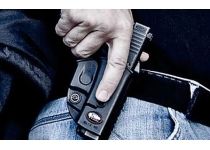 Fobus holsters use Kydex plastic material
Fobus holsters use Kydex plastic materialAnother slick and inexpensive option for competition is anything made from Kydex or plastic or whatever the manufacturer wants to call it. They are fast, often adjustable for cant (the angle of the gun in relation to your body), and nearly indestructible. My Fobus paddle holster has had thousands of draws from it and is nearly as good as the day it was born.
Leather has been the most common holster material since forever, and there are many quality levels. South of our border you might find urine or brain-tanned leather with great prices but with questionable stitching that might last a few draws or with dye that will bleed all over your body, clothes, and gun the first time you perspire. Or you can pay a heftier sum and get a quality horse-leather product made by artisans at places like Galco that will last you lifetimes. The most beautiful holster and belt combination I have ever seen was a Western rig made by Galco for President Reagan.
| Holster Material | Pros | Cons |
|---|---|---|
| Kydex | Don't need to "break in" holster Retains shape for several years Can be molded for your specific handgun model Durable and lightweight Less expensive than leather |
Can wear the finish of your gun Some find it more uncomfortable than leather Louder draws compared to leather |
| Leather | Incredibly durable Quieter draws Classic aesthetic |
Needs to be "broken in" Sweat and moisture can degrade leather |
| Nylon | Least expensive option Easier to find option that fits your gun Durable enough for hunting Quietest draws |
Less security for your gun Less durable than Kydex or leather |
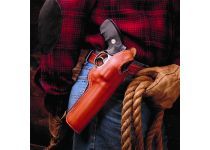 DeSantis 016 Leather Holster for Revolvers
DeSantis 016 Leather Holster for RevolversModern molded holsters are made of plastic, Kydex, carbon-fiber, or other synthetic materials are weatherproof, lightweight, relatively inexpensive, and wear-resistant. Kydex and other synthetic holsters are for the non-traditionalist and are catching on quickly with most manufacturers. Beware, some molded holsters will wear the beautiful blue off your fancy new pistol slide in short order.
I carried a handgun in the thorny bush of Africa in a plastic holster without fear of moisture retention or the gun falling out even through some harried climbs and inadvertent cliff-diving. Indeed, the human body is much more susceptible to breaks, bruises, and scratches than a sturdy molded holster. While not much to look at, plastic handgun holsters are extremely practical and functional.
Nylon holsters are another popular option that gun owners are flocking to these days. Usually found in OWB (Outside the Waistband) configurations, Cordura nylon holsters are not as sturdy as Kydex or leather, but they offer more durability than a standard plastic holster. These holsters aren't molded for a specific gun model, which makes it easier to find one that fits your weapon. However, that also means they provide less security for your weapon so you must be extra vigilant while carrying with a nylon holster.
Types of Gun Holsters
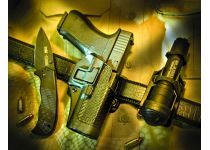 Blackhawk SERPA Belt Holster Sample Set-Up
Blackhawk SERPA Belt Holster Sample Set-UpGun holsters should be chosen by your preferred method of carry. Very few states in our great country do not have some provision for concealed or open carry, and more lawful citizens are qualified to do this each year. Keep in mind the key word concealed. Just because you can't see your gun poking out from under your shirt when you look in the mirror does not mean that you won't scare the checkout employee when you pick up a can of soup from the bottom shelf at the grocery store and your spiffy new hogleg rides up from under your coat. Concealed means concealed under all circumstances: in your car, on your motorcycle, at the mall, or pushing your baby carriage. Shirttails, coats, or long blouses are a must in almost all cases, so a CCW holster that protrudes from your normal garb won't work.
People that drive a lot might consider a cross-draw holster. For a right-handed person, this will be worn between the front of your left hip and your navel, with the grip down and towards the center of your body as comfortably as possible. Besides a shoulder holster or off-the-body carry, this is the easiest position to draw a gun from while seated in a vehicle, and also offers great concealment during daily activities. Many cross-draw holsters such as the Galco Phoenix also offer strong-side hip placement with the same holster due to variously positioned belt slots.
Hip, Belt, Shoulder, and Ankle Holsters
Belt holsters are worn pretty comfortably on the hip bone, or in front or in back of it. In front may poke your stomach and thigh when you sit, and in the rear it may literally be a pain in the butt.
Your body type may preclude the wearing of certain holsters. A person with a large belly may not even be able to find his gun under his ample proportion, let alone draw it, and my bony body will not let me comfortably wear a gun directly on my hip bone. In these cases, an Outside-the-Waistband, or OWB holster, may be a more comfortable option, but they are harder to conceal in standard street clothes.
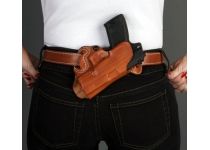 Proper way to wear a Small-of-Back holster
Proper way to wear a Small-of-Back holsterShoulder holsters are convenient and comfortable if adjusted to fit your physique, and I keep one handy and filled for perusing the estate when things go bump in the night. Paddle holsters offer the same beltless grab-and-go usefulness. Ankle holsters are fairly useless for most applications and can be quite uncomfortable for long-term wear.
Small-of-the-back (S.O.B.) holsters lay on your vertebrae and often hurt thinner folks like me. Don't fall backwards with your gun under your spine, or risk serious injury. Regarding firearm placement: position the pistol in your particular S.O.B. holster so that when you draw, the muzzle will not cross your body. This goes for inside-the-waistband, or IWB holsters, worn alongside your spine as well. Many people think that for a right-handed person to draw a gun from this placement the grip should be facing the strong side. WRONG. Think about it. When a right-handed person draws a gun from their back with the grip facing outward, the muzzle naturally crosses their torso. If the grip points towards their spine instead, the gun is naturally removed out and away from the waist.
Bra holsters are an option for some women, but I am told, and can imagine, that they are terribly uncomfortable, as are belly bands. Thigh holsters are for Bond girls only. Some people prefer to carry in a purse holster or fanny pack. There are a plethora of holster options that can blend in with your daily wardrobe.
Inside-the-Waistband & Paddle Holsters
The popular and inexpensive inside-the-waistband holsters are often flexible and mostly comfortable until you put a gun in them. Svelte people with painted on jeans may find it impossible to scour for the extra couple inches needed to insert a gun into their waistband, and a sharp rear sight or hammer can quickly pinch and abrade skin.
Paddle holsters have an extra attached flat tongue that is sandwiched between your body and pants, and include a portion that grips your belt or waistband to prevent the holster coming out while drawing your gun. Paddles are mostly used for convenient installation and removal without threading a belt through, and in fact often don't require the use of a belt at all, depending partially on the type of pants. Most paddles work extremely well and are quite secure.
So what's the best concealed carry holster? Let's break down some of the most popular carry options.
- OWB Holster: Quick draws and maximum comfort but are less discreet and harder to conceal with clothing
- IWB Holster: Easy to conceal weapon but slower draws. Can be uncomfortable for some
- Small of Back (SOB): Can be uncomfortable, especially while driving. Slower draws. Increases risk of injury if you fall on your back.
- Shoulder: Comfortable and convenient. Harder to find the right fit
Holster Tips You Should Know
What Holster is Best for Hunting?
 Uncle Mikes Scoped Bandolier Kodra Holster
Uncle Mikes Scoped Bandolier Kodra HolsterA field hunter will do well with a standard nylon holster / Cordura hip holster with a strap or flap, or you could use the same setup with a leather holster, but it will cost you more. Remember, leather retains moisture for a long time and is heavier. It smells great, though, and gets more character with age. Most hunters will get by fine with an inexpensive, but good quality gun holster of any kind since it will be used just a few days out of the year and should last a lifetime.
Large, heavy handguns and virtually all scoped handguns are best carried in a bandolier holster in the middle of the chest. They distribute the weight evenly and comfortably with an adjustable harness, and draw speed is not an issue.
How to Choose a Holster Retention
Most holsters have some kind of retention device to prevent losing the gun during physical activity. The simplest form of retention is friction, either around the whole gun in the case of leather holsters or around the trigger guard in many molded holsters. Snaps are the most common form of retention, with some requiring force in a specific direction to release. Snaps may be opened either towards or away from the body.
Retention devices can be passive or active. Passive retention usually requires you to draw the gun a certain way for it to be released. However, active retention requires you to perform a specific action to release the holster, like activating a thumb break or thumb loop. Holster retention levels don't only specify the level of security, but they also tell you how many retention devices are in play to secure your weapon. More retention devices = more security but more complex draws.
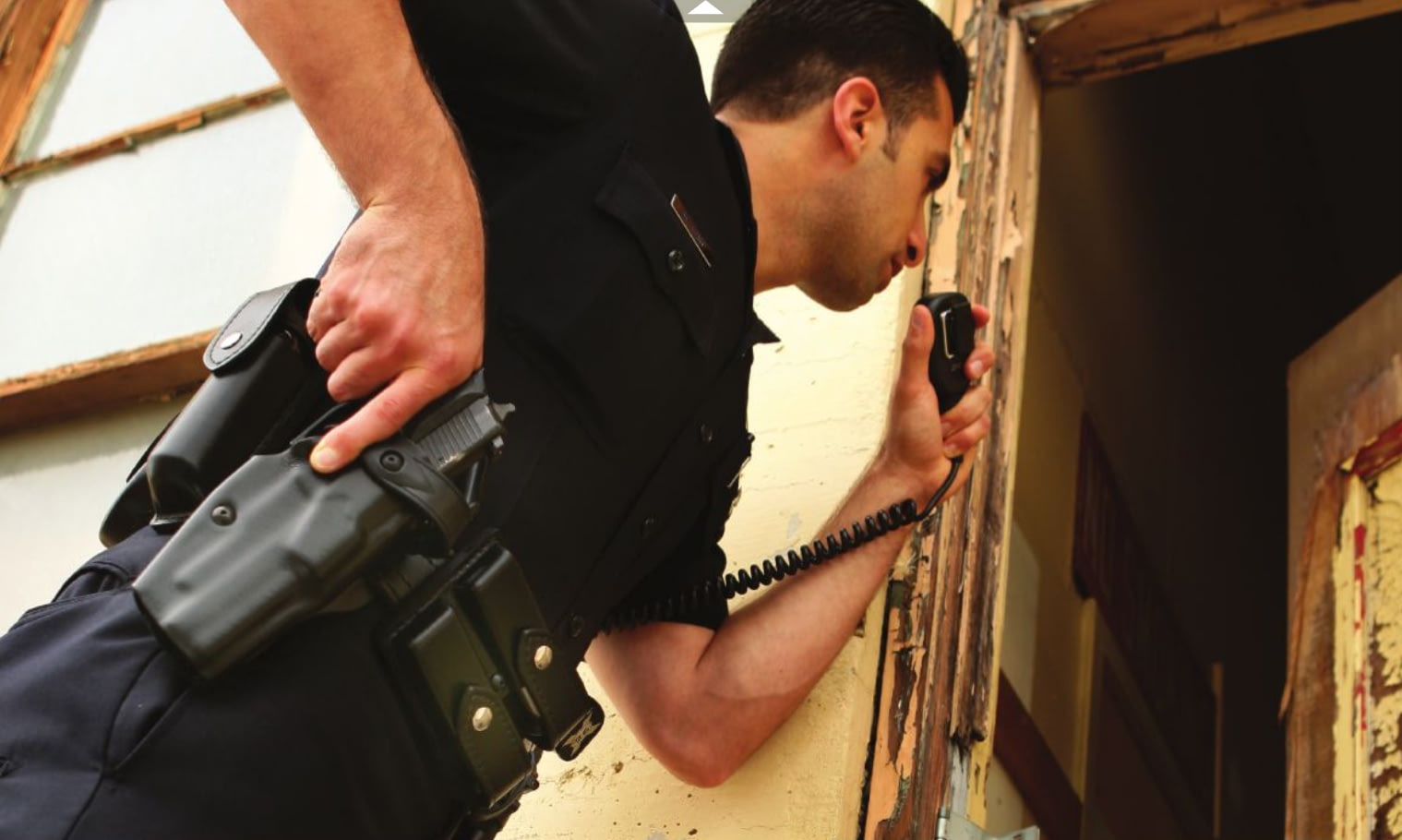 Most police holsters are Level 2 retention or higher
Most police holsters are Level 2 retention or higherMany law enforcement security holsters require the gun to first be pushed, pulled, or canted in a certain way before the gun can be removed, often in conjunction with a snap and either friction or a hood covering the top of the gun, particularly with molded holsters. A holster with three different methods of retention is called a "level 3" security holster, and prevents uniformed law enforcement personnel from having their gun taken away from them during an altercation.
Holster Retention Levels Explained
- Level I: Contains 1 passive retention device. Most concealed carry holsters are Level 1. Minimal security but maximum draw speed.
- Level II: Contains 1 active and 1 passive retention device. Good for open carry and certain law enforcement.
- Level III: Contains 3 total retention devices. Most common level for law enforcement.
- Level IV: Contains 1 passive and 3 active retention devices. Least common option. Offers maximum security but can be very difficult to draw.
A new generation of molded security holster is now available, having more ease of use than ever, and an example is the Serpa line of holsters from Blackhawk. Some of these holsters are level two, some are three, but are nearly as easily drawn from as a non-security holster, with well thought-out and ergonomically placed releases that barely slow draw time. This type, and others like them, are also modular, meaning you can buy only one holster for your particular gun that can be attached to a variety of backing platforms such as paddles, shoulder harnesses, belts, load bearing vests, or thigh rigs. These are much more economical than buying various complete holsters. You can also purchase a holster for a different gun and use the same backing platforms as previously mentioned. All are easily connected with just a few screws.
Important Info About Leather Holsters
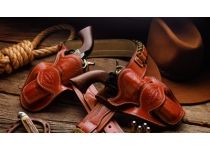 DeSantis Desperado Holster Rig
DeSantis Desperado Holster RigWhen you receive your new leather holster you may notice that is very tight, or the thumb break snap pieces are too far away to close. This is perfectly normal. The fibers of the leather may take a while to loosen up. The proper way to do this is to pull and bend, without creasing, the strap between your fingers. Just like that new pair of shoes or a baseball mitt, it takes a while for the leather to stretch and conform to what is being put in it. Do not use any conditioner like leather softener or mink oil, as these agents will continue working and make the holster too supple and loose. Keep manipulating the strap until it snaps. Just leaving your gun in a tight leather holster does very little to help the break in. You need to work the leather. Leather cleaner and conditioner is a great way to keep your fine leather holster from staining and drying out.
Remember:
1. Try to buy a holster for a specific intended purpose such as concealed carry, competition, plinking in the woods, etc.
2. A higher price generally means better construction and longevity, particularly with leather holsters.
3. Modular systems are the most economical, particularly if you use a variety of firearms.
4. You can never have too many holsters.
5. For concealed carry holsters, practice draws and re-holstering often using the clothes you normally wear.
6. Make sure your CCW firearm is truly concealed under your normal garb in a variety of positions. Another set of eyes is much more beneficial than you looking in the mirror.
7. Most of this article applies to mag pouches and flashlight holsters, as well.








